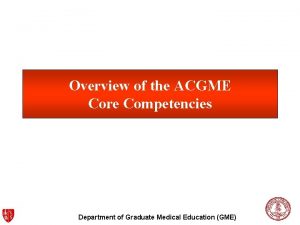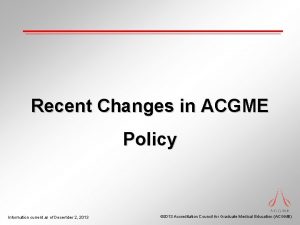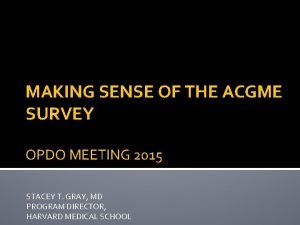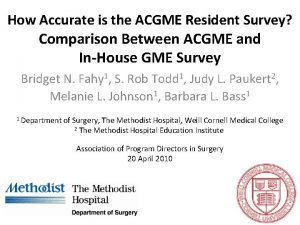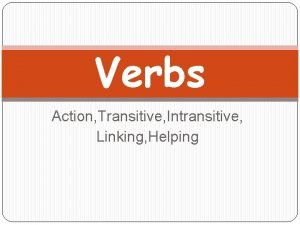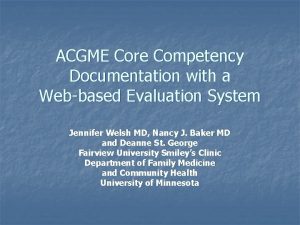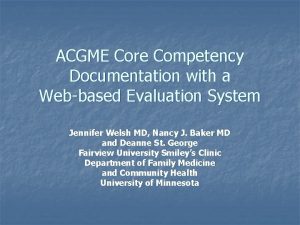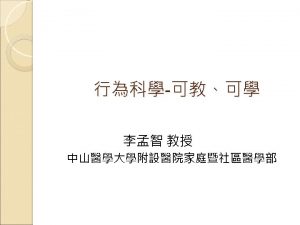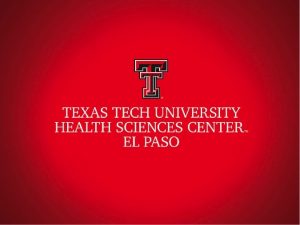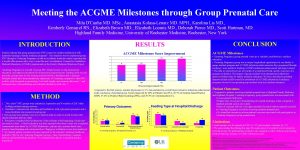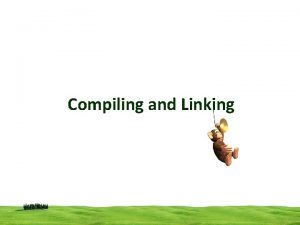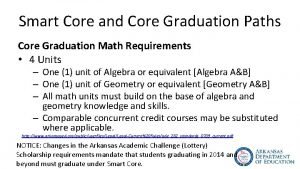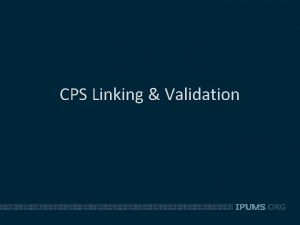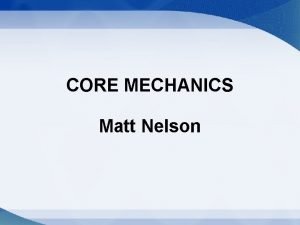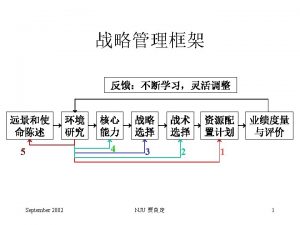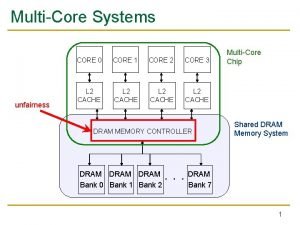Linking Outcomes of Care and the ACGME Core











































- Slides: 43

Linking Outcomes of Care and the ACGME Core Competencies: A Matrix Solution Competencies Working Group January 5, 2007 Doris Quinn, Ph. D Assistant Professor Division of Medical Education 2006 Vanderbilt University Medical Center John Bingham, MHA Director Center for Clinical Improvement

Objectives for today: 1. Review the link between: • Outcomes of Care (IOM Aims for Improvement) • The ACGME Core Competencies 2. Demonstrate how the Healthcare Matrix is used to improve the delivery of care and education 2006 Vanderbilt University Medical Center 2

Drivers of Change in Healthcare: 1999 2001 2002 2003 Emerging public reporting and awareness of quality measures 2006 Vanderbilt University Medical Center 3

Patient Care should be: Safe, Timely, Effective, Efficient, Equitable, Patient-Centered (STEEEP) 2006 Vanderbilt University Medical Center 4

7/2001 6/2002 7/2002 Phase I • Define specific objectives for residents to demonstrate learning of the competencies. • Begin integrating the teaching and learning of competencies into residents’ didactic and clinical experiences. 6/2006 7/2006 6/2011 7/2011 Beyond Phase III Phase IV • Improve the evaluation processes for all six of the Competencies. • Use resident performance data as the basis for improvement. • Identify benchmark programs. • Provide aggregated resident performance data for Internal Review Process. 2006 Vanderbilt University Medical Center • Begin to use external quality measures to verify resident and program performance levels. • Involve community in building knowledge about good GME. 5

Public Reporting of Quality • • • CMS Quality Measures (CMS Compare) Accreditation Bodies (JCAHO) Statewide Organizations (QIOs) Business Coalitions (Leapfrog) Employers (Annual Enrollment Process) Commercial Health Care Scorecards – (www. healthgrades. com) 2006 Vanderbilt University Medical Center 6

The future…. in a few words: Transparency Process Reliability 2006 Vanderbilt University Medical Center 7

So…what should we do? Patients with Needs Met Access Assessment Diagnosis Treatment Follow-up 1. Define the measures that matter 2. Measure our performance 3. Utilize the results of measurements to improve: • • The education of residents and allied professionals The quality of care that we provide 2006 Vanderbilt University Medical Center 8

Patient Care should be: Safe, Timely, Effective, Efficient, Equitable, Patient-Centered (STEEEP) 2006 Vanderbilt University Medical Center 9

Healthcare Matrix: Care of Patient(s) with…. Competencies Aims SAFE TIMELY EFFECTIVE EFFICIENT EQUITABLE PATIENTCENTERED Assessment PATIENT CARE (Overall Assessment) Yes/No MEDICAL KNOWLEDGE (What must we know) INTERPERSONAL AND COMMUNICATION SKILLS (What must we say) PROFESSIONALISM (How must we act) SYSTEM-BASED PRACTICE (What is the Process? On whom do we depend and who depends on us) Improvement PRACTICE-BASED LEARNING AND IMPROVEMENT (What have we learned, what will we improve) 2006 Vanderbilt University Medical Center © 2004 Bingham, Quinn Vanderbilt University 10

PATIENT CARE that is… Safe “Avoiding injuries to patients from the care that is intended to help them” 2006 Vanderbilt University Medical Center 11

PATIENT CARE that is… Safe • Percent of Surgeries with appropriate “timeout” • Prophylactic Antibiotics for all surgeries • Use of Central-line Bundle • Use of Ventilator Acquired Pneumonia Bundle • Glycemic Control • Hand Hygiene • Leapfrog’s 30 Safe Practices 2006 Vanderbilt University Medical Center 12

PATIENT CARE that is… Safe Timely “Reducing waits and sometimes harmful delays for both those who receive and those who give care” 2006 Vanderbilt University Medical Center 13

PATIENT CARE that is… Safe Timely Effective “Providing services based on scientific knowledge to all who could benefit and refraining from providing services to those not likely to benefit” 2006 Vanderbilt University Medical Center 14

PATIENT CARE that is… Safe Timely Effective Efficient “Avoiding waste, including waste of equipment, supplies, ideas, and energy” 2006 Vanderbilt University Medical Center 15

PATIENT CARE that is… Safe Timely Effective Efficient Equitable “Providing care that does not vary in quality because of personal characteristics such as: gender, ethnicity, geographic location, and socio-economic status” 2006 Vanderbilt University Medical Center 16

PATIENT CARE that is… Safe Timely Effective Efficient Equitable Patient Centered “Providing care that is respectful of, and responsive to: • individual patient preferences, • needs and values, • and ensuring that patient values guide all clinical decisions” 2006 Vanderbilt University Medical Center 17

What must we know? PATIENT CARE that is… Safe Timely Effective Efficient Equitable Patient Centered Medical Knowledge “…about established and evolving biomedical, clinical, and cognate sciences, (e. g. epidemiological and social-behavior) and the application of this knowledge to patient care” 2006 Vanderbilt University Medical Center 18

What must we say? PATIENT CARE Safe Timely Effective Efficient Equitable Patient Centered Medical Knowledge Interpersonal and Communication Skills “…that result in effective information exchange and teaming with patients, their families, and other health professionals. ” 2006 Vanderbilt University Medical Center 19

How must we behave? PATIENT CARE Safe Timely Effective Efficient Equitable Patient Centered Medical Knowledge Interpersonal and Communication Skills Professionalism “…as manifested through a commitment to carrying out professional responsibilities, adherence to ethical principles, and sensitivity to a diverse patient population. ” 2006 Vanderbilt University Medical Center 20

What is the Process? On whom do we depend? Who depends on us? PATIENT CARE Safe Timely Effective Efficient Equitable Patient Centered Medical Knowledge Interpersonal and Communication Skills Professionalism System-Based Practice “…as manifested by actions that demonstrate an awareness of, and responsiveness to, a larger context and system of healthcare and the ability to effectively call on system resources to provide care that is of optimal value. ” 2006 Vanderbilt University Medical Center 21

What have we learned? What will we improve? PATIENT CARE Safe Timely Effective Efficient Equitable Patient Centered Medical Knowledge Interpersonal and Communication Skills Professionalism System-Based Practice-Based Learning & Improvement “…involves investigation and evaluation of their own patient care, appraisal and assimilation of scientific evidence, and improvements in patient care. ” 2006 Vanderbilt University Medical Center 22

Linking it all together…. Patients with Needs Met Access Patient Care that is… Assessment Safe Timely Diagnosis Effective Treatment Efficient Follow-up Equitable Patient Centered Clinicians competent in: -Medical Knowledge -Interpersonal and Communication Skills -Professionalism -System-Based Practice -Practice-Based Learning & Improvement 2006 Vanderbilt University Medical Center 23

Healthcare Matrix: Care of Patient(s) with…. Competencies Aims SAFE TIMELY EFFECTIVE EFFICIENT EQUITABLE PATIENTCENTERED Assessment PATIENT CARE (Overall Assessment) Yes/No MEDICAL KNOWLEDGE (What must we know) INTERPERSONAL AND COMMUNICATION SKILLS (What must we say) PROFESSIONALISM (How must we act) SYSTEM-BASED PRACTICE (What is the Process? On whom do we depend and who depends on us) Improvement PRACTICE-BASED LEARNING AND IMPROVEMENT (What have we learned, what will we improve) 2006 Vanderbilt University Medical Center © 2004 Bingham, Quinn Vanderbilt University 24

Applications of the Matrix I. Individual Resident Learning II. Case Presentations III. M & M Conference IV. Linking to External Quality Metrics V. Curriculum Framework VI. Medical Students 2006 Vanderbilt University Medical Center 25

Using the Matrix § § § History Physical Exam Labs Diagnosis Tests Consults Etc. 2006 Vanderbilt University Medical Center Care of Patient (Matrix) 26

Anesthesia: One resident’s learning A resident prepared for a case presentation and addressed the following cells. IOM SAFETY TIMELINESS EFFECTIVENESS EFFICIENCY EQUITABILITY PATIENT CENTEREDNESS No No ACGME PATIENT CARE MEDICAL KNOWLEDGE & APPLICATION No No X X PROFESSIONALISM INTERPERSONAL & COMMUNICATION SKILLS SYSTEMS- & TEAMS-BASED PRACTICE X PRACTICE-BASED LEARNING & IMPROVEMENT (Process to Improve) 2006 Vanderbilt University Medical Center 27

After a dialogue with faculty and using the Matrix, she then addressed all of the following cells in her presentation. The presentation resulted in the improvements outlined below. IOM TIMELINESS EFFECTIVENESS X X X P and P changed for Mom/Child in trouble Changed STAT pages to Anes. From OB Class on care of Mom with DIC Procedure outlined for fastest prep for OR SAFETY EFFICIENCY EQUITABILITY PATIENT CENTEREDNESS ACGME PATIENT CARE MEDICAL KNOWLEDGE X PROFESSIONALISM INTERPERSONAL & COMMUNICATION SKILLS SYSTEMS- & TEAMS-BASED PRACTICE-BASED LEARNING & IMPROVEMENT (Process to Improve) 2006 Vanderbilt University Medical Center X X X Assure Mom aware of what is happening. Communication with father. 28

Simple Matrix • Not all cells need to be filled in, but it’s important to address those cells pertinent to the case. • One or more cells may be critical or significant to the case (hot cells). 2006 Vanderbilt University Medical Center 29

2006 Vanderbilt University Medical Center 30

Usual Morbidity and Mortality Conferences 2006 Vanderbilt University Medical Center 31

Major focus on Medical Knowledge 2006 Vanderbilt University Medical Center 32

With All Competencies Reviewed 2006 Vanderbilt University Medical Center 33

2006 Vanderbilt University Medical Center 34

Analyzing Data from Multiple Matrices 2006 Vanderbilt University Medical Center 35

2006 Vanderbilt University Medical Center 36

Healthcare Matrix: Care of Patient(s) with…. Competencies Aims SAFE TIMELY EFFECTIVE EFFICIENT EQUITABLE PATIENTCENTERED Assessment PATIENT CARE (Overall Assessment) Yes/No MEDICAL KNOWLEDGE (What must we know) INTERPERSONAL AND COMMUNICATION SKILLS (What must we say) PROFESSIONALISM (How must we act) SYSTEM-BASED PRACTICE (What is the Process? On whom do we depend and who depends on us) Improvement PRACTICE-BASED LEARNING AND IMPROVEMENT (What have we learned, what will we improve) 2006 Vanderbilt University Medical Center © 2004 Bingham, Quinn Vanderbilt University 37

Key Safety Issues Identified for VUMC • COMMUNICATION • TEAMWORK (especially relationship between specialties) • WORKAROUNDS (time stealer) • DOCUMENTATION • Unnecessary Variation • Complexity of patients and limited clinic time • Updated medication and problem lists critical for optimal care • Getting lab values quickly and alerts for abnormal ones • Interpreters for growing number of non-English speaking patients (system not based on solely on people) 2006 Vanderbilt University Medical Center 38

Closing the Patient Care Loop • Start with diagnosis as basis for assessment • Identify issues of care related to Aims and Competencies • Identify lessons learned and improvement needed • Complete action plan for improvements with accountabilities and timeline 2006 Vanderbilt University Medical Center 39

2006 Vanderbilt University Medical Center 40

2006 Vanderbilt University Medical Center 41

Healthcare Matrix: Care of Patient(s) with Stroke Competencies Aims SAFE TIMELY EFFECTIVE EFFICIENT EQUITABLE PATIENTCENTERED Assessment PATIENT CARE (Overall Assessment) Yes/No MEDICAL KNOWLEDGE (What must we know) An Oracle Database is being built that will collect data from each cell and allow analysis and reports to be generated by: INTERPERSONAL AND COMMUNICATION SKILLS • Institution • Department • Diagnosis • IOM Aim • Competency (What must we say) PROFESSIONALISM (How must we act) SYSTEM-BASED PRACTICE (What is the Process? On whom do we depend and who depends on us) Improvement PRACTICE-BASED LEARNING AND IMPROVEMENT (What have we learned, what will we improve) 2006 Vanderbilt University Medical Center © 2004 Bingham, Quinn Vanderbilt University 42

2006 Vanderbilt University Medical Center 43
 Acgme core competency
Acgme core competency Wang xiaomin
Wang xiaomin Acgme accreditation withheld
Acgme accreditation withheld Acgme survey questions
Acgme survey questions Acgme resident survey
Acgme resident survey Eric holmboe acgme
Eric holmboe acgme Primary secondary tertiary medical care
Primary secondary tertiary medical care The brittle, rocky outer layer of earth
The brittle, rocky outer layer of earth Crust mantle core
Crust mantle core Core capabilities and core rigidities
Core capabilities and core rigidities Basic layers of the earth
Basic layers of the earth Lesson 5 verbs action (transitive/intransitive) answer key
Lesson 5 verbs action (transitive/intransitive) answer key Unit 2 equality diversity and rights
Unit 2 equality diversity and rights Hát kết hợp bộ gõ cơ thể
Hát kết hợp bộ gõ cơ thể Bổ thể
Bổ thể Tỉ lệ cơ thể trẻ em
Tỉ lệ cơ thể trẻ em Voi kéo gỗ như thế nào
Voi kéo gỗ như thế nào Tư thế worm breton là gì
Tư thế worm breton là gì Hát lên người ơi alleluia
Hát lên người ơi alleluia Các môn thể thao bắt đầu bằng tiếng chạy
Các môn thể thao bắt đầu bằng tiếng chạy Thế nào là hệ số cao nhất
Thế nào là hệ số cao nhất Các châu lục và đại dương trên thế giới
Các châu lục và đại dương trên thế giới Công của trọng lực
Công của trọng lực Trời xanh đây là của chúng ta thể thơ
Trời xanh đây là của chúng ta thể thơ Mật thư anh em như thể tay chân
Mật thư anh em như thể tay chân 101012 bằng
101012 bằng Phản ứng thế ankan
Phản ứng thế ankan Các châu lục và đại dương trên thế giới
Các châu lục và đại dương trên thế giới Thơ thất ngôn tứ tuyệt đường luật
Thơ thất ngôn tứ tuyệt đường luật Quá trình desamine hóa có thể tạo ra
Quá trình desamine hóa có thể tạo ra Một số thể thơ truyền thống
Một số thể thơ truyền thống Cái miệng bé xinh thế chỉ nói điều hay thôi
Cái miệng bé xinh thế chỉ nói điều hay thôi Vẽ hình chiếu vuông góc của vật thể sau
Vẽ hình chiếu vuông góc của vật thể sau Nguyên nhân của sự mỏi cơ sinh 8
Nguyên nhân của sự mỏi cơ sinh 8 đặc điểm cơ thể của người tối cổ
đặc điểm cơ thể của người tối cổ V cc cc
V cc cc Vẽ hình chiếu đứng bằng cạnh của vật thể
Vẽ hình chiếu đứng bằng cạnh của vật thể Tia chieu sa te
Tia chieu sa te Thẻ vin
Thẻ vin đại từ thay thế
đại từ thay thế điện thế nghỉ
điện thế nghỉ Tư thế ngồi viết
Tư thế ngồi viết Diễn thế sinh thái là
Diễn thế sinh thái là
